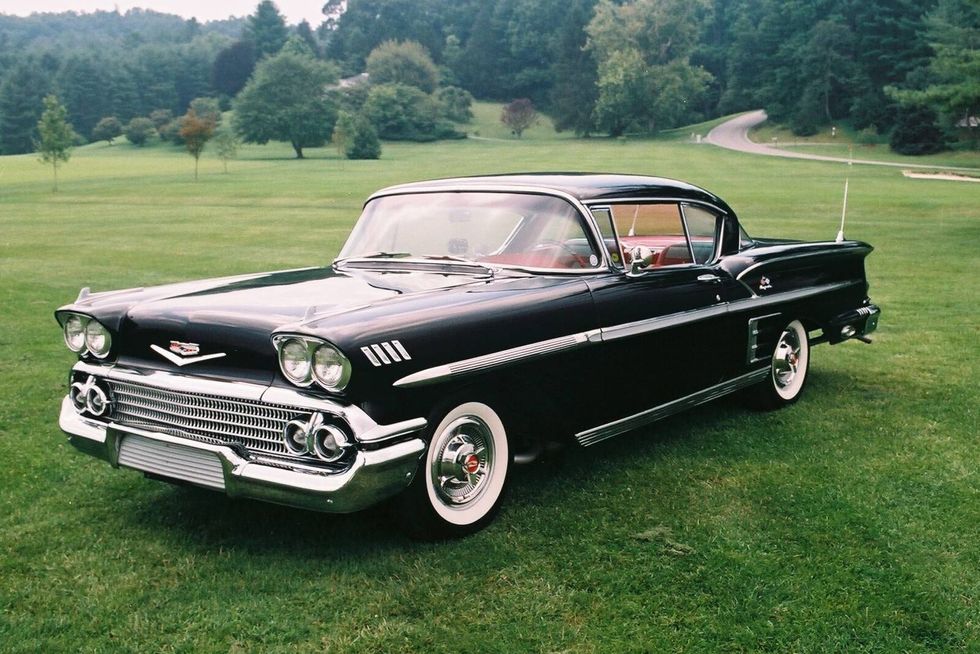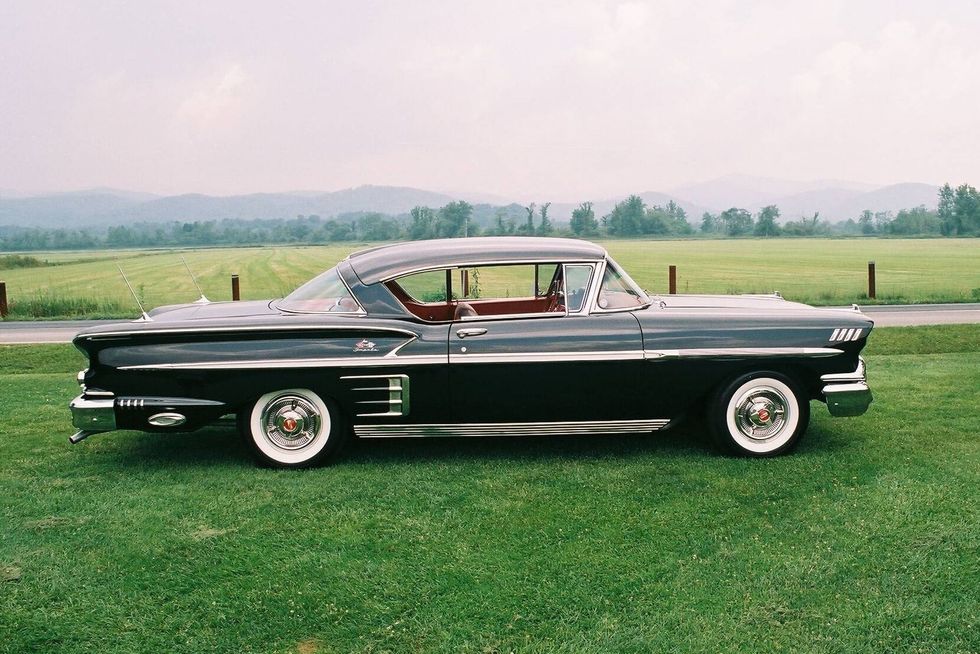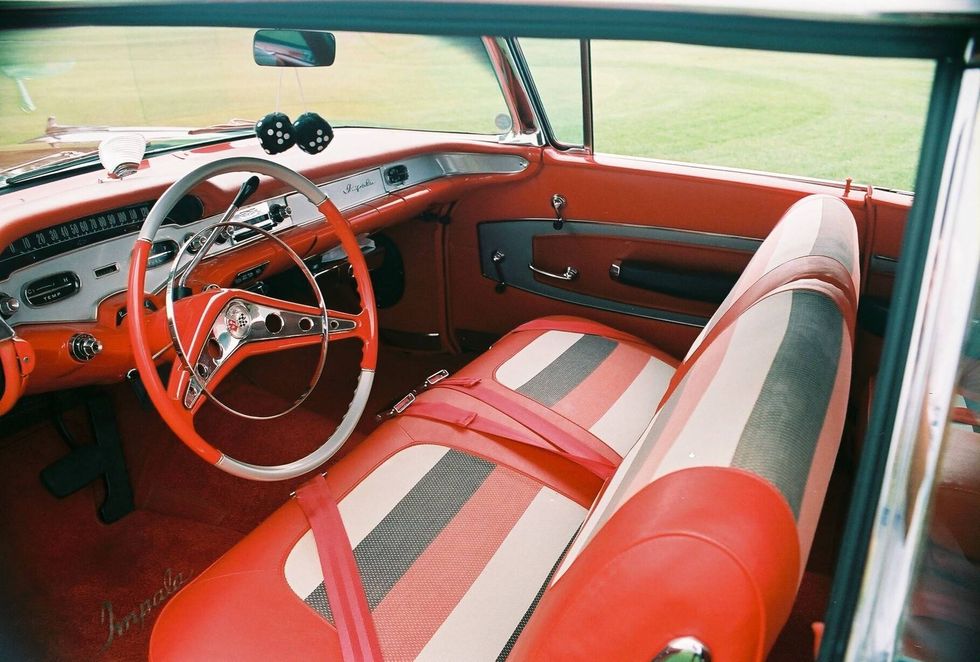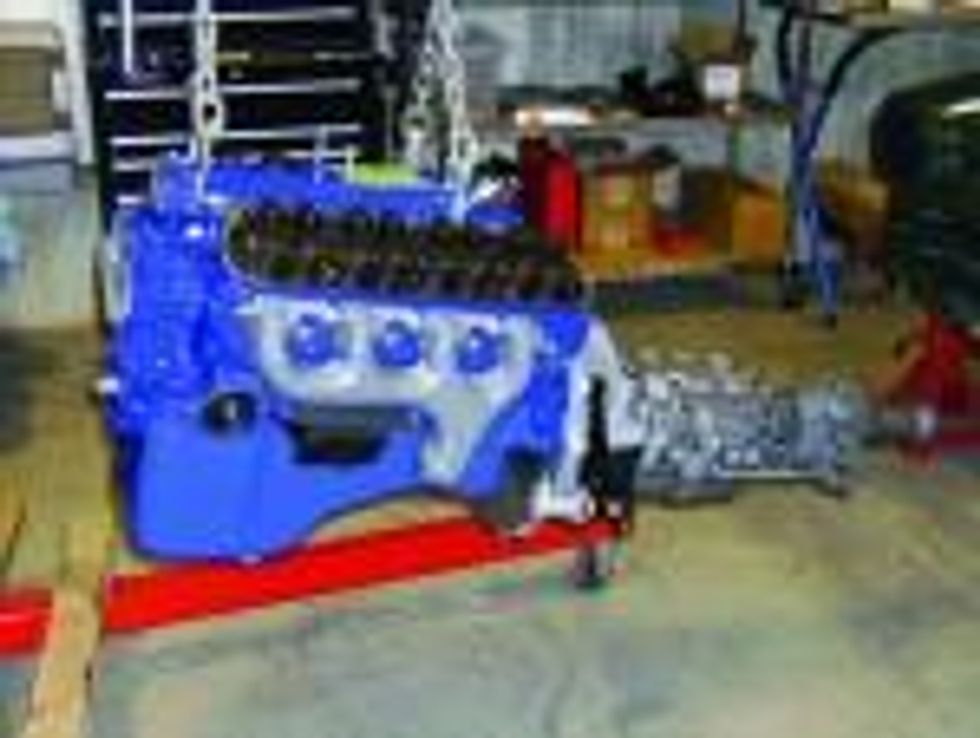
Buy
Resources
Entertainment
Magazine
Community
1966 Sunbeam Tiger. Photo Courtesy: David LaChance.
If you're among the many who got to know Andy Rooney through his weekly commentaries on 60 Minutes, you might describe him as irascible. Fellow CBS newsman Morley Safer fondly called him "America's grouch-in-chief." Author and news anchor Tom Brokaw once wrote, "Our mutual friends confirmed that off the air he was equally iconoclastic, an impish curmudgeon." Many were the things that he loved to complain about, from cotton in pill bottles to modern public art to gifts from fans. "Being liked is nice, but it's not my intent," he said in his final broadcast on October 2, 2011.
His on-screen persona was anything but sentimental. But away from the camera, it was a different story. "He was one of the most nostalgic people you'll ever meet in your life," recalls his daughter Emily. "Everything about him was sentimental and nostalgic. He couldn't sell anything, he couldn't give anything away. He just couldn't bear to get rid of anything."
Photo Courtesy: Emily Rooney.
That certainly applied to his 1966 Sunbeam Tiger, a car he'd bought new. Rooney didn't show much of his gearhead side in his columns and commentaries, but he loved fast drives in his Tiger, and, Emily says, could recite the specifications of its 260-cu.in. Ford V-8. He did mention the car in print at least once, in a 1998 column:
"It's a sad fact of life that gratification is usually the death of desire. Once you have the object of desire you don't want it anymore.
"For years I wanted a little sports car with lots of power. That was slow coming, too. In 1966, I finally got what I wanted, a Sunbeam Tiger, British racing green, with a Ford V-8 engine under its bonnet. I still own it, and it weakens my theory about gratification and desire because I like having it today as much as I did the day I bought it."
Emily Rooney in her father's now-restored Tiger. Photo Courtesy: David LaChance.
Like so many GIs before him, Rooney came to learn about British sports cars during his service in World War II. (Military service also launched his lifelong journalistic career, when he became a correspondent for The Stars and Stripes.) The Tiger was not his first British car; Emily remembers a TR4 that preceded it in the early 1960s. "He only kept it a few years, and he had his sights on this one [the Tiger] because the engine was so much bigger and the car was much more powerful."
He bought the Tiger from Felix F. Callari, the president of Continental Motors in Stamford, Connecticut. Rooney kept his correspondence from Callari, including a 1979 letter in which the dealer gently prodded his famous customer about buying another car. Rooney responded, "I still drive, maintain and enjoy the Sunbeam Tiger you sold me in 1966-'67 for about $3,600. Anytime you have a car that can come anywhere near matching its performance, let me know."
Photo Courtesy: David LaChance.
"He did like to drive fast," recalls Emily, who has built her own career in journalism, currently serving as the host, executive editor and creator of Greater Boston and Beat the Press on WGBH TV in Boston. "He was a very aggressive driver--taxicab-style. He didn't take cabs, he only drove, even in New York City, even when he was old. He drove to restaurants, he parked outside, he drove to work every day; he hassled with finding a parking space.
"He used it as his station car," she adds. "He left it at the station--and he had this rule about keys: You had to leave the keys in the ignition at all times." The Tiger was usually parked on the family driveway at night, and yet somehow never got stolen, though this policy once cost Rooney a Ford Thunderbird.
Photo Courtesy: David LaChance.
When Emily and her twin sister, Martha, learned to drive, the Tiger was the car they learned in. "He bought it the year I turned 16. He would just hand us the keys and say, 'Don't grind the gears,'" she laughs. "We didn't know what we were doing. I didn't know what a clutch was. We lived on a hill, and I can remember trying to start that thing on a hill, rolling 60 miles an hour backwards, thinking, 'What are you supposed to do here?'" Her dad apparently subscribed to the sink-or-swim theory of driver education. "He would just hand us the keys. He wouldn't even get in the car with us!"
Martha, Emily and the Tiger all survived the experience, though the roadster had no pampered life in Rooney's care. He could be an impatient driver, and once accidentally rammed another car on an onramp to the New York State Thruway because he assumed the other driver was merging into traffic. "I remember him saying, 'The other guy didn't know how to merge,'" Emily laughs.
Maintenance was on the infrequent side; oil changes he apparently considered some sort of a rip-off. "He'd say, 'They tell you to change the oil, you don't need to put oil in the car,'" she says, doing a pretty credible Andy Rooney impression. "Let me be clear: He was extremely generous," she continues. "None of his friends ever paid for dinner. He was very generous. But he had this penurious side that was the opposite of his generosity."
Photo Courtesy: David LaChance.
Concerned about its soundness, Rooney had the car overhauled when it was about 12 years old. "I don't want the car 'restored' in the classic sense. I don't show it, I drive it," he wrote to Patchen's Auto Body, the Norwalk, Connecticut, shop that did the work. For the last 20 years of his life, he kept the car garaged in Rensselaerville, New York, where his wife's family had property. It had been sitting for two years when Emily and a friend went out to get the car running in 2009, only to discover that "It had all kind of problems. It was undriveable. He didn't realize that; he said there was nothing wrong with it.
"I didn't realize the extent of the disrepair. I could see that the animals had eaten the covers away; he kept it in an unheated garage with the top down. So every kind of animal was in there--raccoons, mice, squirrels, everything."
Emily got an idea: She would have the car restored, and surprise her father with it. But she had never dealt with automotive restoration before, and didn't know how involved it could be. "My thought was to get it back to him, so that he would have it. I didn't know anything about this. I thought that it would be a couple of months," she says.
On the advice of her friend Craig Carlson, who was knowledgeable about such things, she decided to approach Whitehall Auto Restorations in Hopkinton, Massachusetts, about the work. Craig "had to really convince them. They didn't want to do it. First of all, it's not their specialty, and secondly, they're really busy. They kind of did it as a favor. For a while there, I was kind of riding them, and then I realized, wait a second, they're helping me out here; I'm just going to chill and go with it. When I went out there and I saw that they had taken the car apart, down to the bolts and nuts, I thought, 'Oh, we're in for it here.'"
Ken Wilcox, of Whitehall, remembers examining the car in Rensselaerville. "Everything seemed to work, just not well. Everything was worn out," he says. Whitehall agreed to take the car on, and Ken agreed with owner Tom White's suggestion that he do the work in the shop at his home, bringing it back to Whitehall as needed. "Sometimes, if a car comes in that's a little bit outside of what we do here at 34 Spring Street, we can still get it done. It's something that Tom's comfortable with," Ken says. "Tom is so willing to try anything, he's an amazing guy. He'll do anything, he'll try anything. I kind of like that attitude. It gets a little infectious."
Restoration Photos Courtesy: Whitehall Auto Restorations.
Early in the process, Ken got in touch with Norm Miller, the keeper of the Tiger registry, who confirmed that the engine, gearbox and differential were all original to the car. The Whitehall team--Ken, Tom, and Tom's sons Chris and Larry--consulted with Emily and Craig, and agreed on the parameters of the job: "Let's make it nice, without going for points at the show," Ken says. "It needed to be driveable and look good."
Two determinations helped to save time and money. The paint that had been applied back in 1978 was still in good condition, and could be brought back to a good gloss with buffing. The only real damage was a small dent in a rear quarter, which Ken could repair and refinish, blending the new paint into the old. And the major mechanical bits, the engine, gearbox and differential, were in good enough condition that rebuilds were unnecessary. These would be cleaned, resealed, and cosmetically restored.
Underneath, Ken found a few spots in the unit-body that had corroded, and needed new metal welded in. Beyond that, "there was no significant rust, no rot," he says. Suspension components were disassembled, media-blasted and refinished, either powdercoated or sprayed with PPG Concept single-stage urethane. He was surprised to find that some components, such as the driveshaft and rear leaf springs, were virtually as new, although he knew they were originals.
All of the soft parts of the interior needed replacement. Justin Zuffante of Seamless Custom in Leicester, Massachusetts, spec'd, ordered and installed an upholstery kit from Sunbeam Specialties of Campbell, California, the specialist that supplied most of the parts used in the restoration. "It ended up being a very, very nice kit," Ken says. "The cockpit is spectacular." Justin ordered and installed a new folding top as well.
The car was not finished in time for Rooney to see it; he died in early November 2011, less than five weeks after his last appearance on 60 Minutes. He was 92. "While Dad never got to see his Tiger in its newly restored pristine state, he did get a final ride," Emily relates in a scrapbook she produced about her father and his car. "In June of 2012 we perched the Tiger Maple urn containing his ashes on the back seat where the dogs and grandkids used to sit and drove him to his burial ground in Rensselaerville, New York. We revved the engine a few times and left him a nip of Maker's Mark.
"He would have liked that."
This article originally appeared in the January, 2014 issue of Hemmings Sports & Exotic Car.
Recent
For 1958, all-new styling at every General Motors passenger-car division ushered in big changes, just as the corporation was celebrating its 50th anniversary. It was also the final year with Harley Earl at the helm of GM design. Though the new models were longer and lower in proportion than in previous years, Earl’s signature use of excessive chrome remained unabated. That brightwork continued a trend that had dominated automotive design throughout the Fifties. For 1958, it worked seamlessly with those new designs that presented a broad departure from previous years.
Currently listed on Hemmings Auctions are a pair of faithfully restored hardtop coupes from the GM catalog from that momentous year. With wide chrome grilles surrounding four headlamps and copious brightwork including side trim the length of the body, this 1958 Chevrolet Impala Sport Coupe and 1958 Pontiac Bonneville Sport Coupe both handsomely display the heavily Earl-influenced styling that made headlines for GM.

1958 Pontiac Bonneville Sport Coupe
While GM made general announcements and events around its 50th anniversary for 1958, only Pontiac incorporated the occasion into its advertising. It mattered little that the first Pontiac rolled off the assembly line in 1926 as sub-brand of Oakland. Laid out in large letters in its brochure, Pontiac’s advertising theme for 1958 carried the tagline “The boldest advance in fifty years,” also declaring “A new kind of cars is born!” Previously introduced as a well-optioned convertible version of the Star Chief in 1957, the standalone Bonneville arrived for 1958.
Promising “the first true union of sport car action with town car luxury,” the Bonneville was only produced as a pillarless hardtop Sport Coupe or a drop-top Sport Convertible for 1958. As “a modern ultimate for the man who loves cars…this steel-muscled road machine,” the Bonneville featured a 370-cu.in. V8 engine with a four-barrel carburetor and 10:1 compression as standard equipment. An optional Tri-Power setup with triple two-barrel carburetors was given the “Tempest 395” moniker for its 395 lb-ft torque rating.

As the late 1950s was peak Jet Age, aeronautical and rocket themes pervade the details of the Bonneville. The leading edge of the scalloped rear quarter panels featured a very rocket-like piece of chrome trim that extended to a point at the front of the car. On top of each front fender, just before the headlamps, sat additional chrome-plated pieces that resembled delta-wing jets with appendages that lead into creases atop the fenders like contrails from jet engines.
Finished in Burma Green with Calypso Green accents, this 1958 Bonneville Sport Coupe, one of 9,144 produced, appears to have been restored some years ago, with a fit and finish that looks to be holding up. It is equipped with the Tri-Power 370 and a four-speed Super Hydra-Matic transmission. It is additionally fitted with power windows and power brakes, along with the rare Trans-Portable radio unit that can be removed and used as a portable radio with its built-in speaker and ability to run off batteries. The seller notes no problems with the drivetrain and asserts that the transmission shifts well.

1958 Chevrolet Impala Sport Coupe

Chevrolet didn’t revel in the golden jubilee news that Pontiac touted, but its advertising in 1958 suggested that its redesigned models were “Almost too new to be true!” The ad copy also promised that “You’ll like being looked at in your beautiful ’58 Chevrolet.” Longer, lower and wider than the famous “Tri-Five” models that preceded it, the Chevrolet models somewhat mirrored what was going on at Pontiac, but with a rear-end treatment that seemed to show the previous year’s tall tailfins flopped over somewhat. In magazines ads, the words accompanying the first-year Impala Sport Coupe suggested “This sleek styles-setter promises action, gaiety, glamor—and it keeps its promises beautifully.”
Like the Bonneville nameplate, the first Chevrolet to wear the Impala badge arrived in 1958. Chevy also introduced its first big-block V8, the so-called “W” engine. For 1958, Chevrolet dubbed this 348-cu.in. engine the Turbo-Thrust V8 when equipped with a four-barrel carburetor and Super Turbo-Thrust when fitted with Tri-Power triple carburetion. Though it lacked the aviation/space themes of the Bonneville’s styling, the similarly proportioned Impala was also festooned with plenty of brightwork, from the wide grille to side spears that ran nearly from the taillights to the headlamps. Pound-for-pound, the massive wraparound bumpers probably contained the highest amount of chrome on the car.

Finished in Onyx Black with a bold Rio Red-dominated interior, this 1958 Chevrolet Impala Sport Coupe now on Hemmings Auctions features a long-term restoration that spanned the 1990s. Completed in 2001, it appears to be holding up well. The photos of the very clean undercarriage that accompany the listing tell a story that the car has been taken care since that redo. This example is fitted with the four-barrel 348 that was rated at 250 horsepower when new. Power reaches the rear axle via a two-speed Powerglide automatic transmission.
GM made some distinct design changes for 1958. With plenty of models across five passenger-car divisions, we are fortunate to have options in the collector car hobby when it comes to these chrome-laden machines. Which of these ’58 hardtop coupes would you like to cruise in?
Head on over to Hemmings Auctions to take a look and let us know.
Keep reading...Show Less
A 1972 Ferrari 246 GT Dino fire survivor is listed for sale online, and it could be the cheapest Ferrari Dino to hit the market in a long while. Would you pick it or kick it?
The hood, which still opens to reveal a 2.4-liter V-6 engine that looks to be salvageable, sports a gaping hole where the flames ate through the steel. The tail and rear quarter panels reflect the front ends condition, and surface rust covers the entire car. Everything that the fire could melt away is gone, including the interior. At one time, the sports car was beautifully upholstered with tan leather and coated with Marrone Colorado brown paint. Now the brown paint is replaced by surface rust covering most of the car. It reportedly was all-original before the fire.
Remember when a crashed Ferrari 500 Mondial sold for nearly $2 million at auction last year? Well, this Dino admittedly isn’t nearly as valuable, nor does it have a racing history, but its final sale price could still surprise you.
“This car clearly needs complete restoration, but the good news is that it's certainly the cheapest one you will ever find,” Gullwing Motor Cars writes, adding, “The Dino market is hot and shows no signs of cooling… This deal is on fire!”
Ferrari created the Dino 246 GT for the 1970 model year to replace the prior 206 GT model. The 246 GT received an increased engine displacement to 2.4 liters, still paired with a five-speed manual transmission. While the 206 GT body was built primarily from aluminum, the 246 GT switched to mostly steel bodywork, which happens to have a higher heat resistance.
Production of the Dino 246 GT ended in 1974 with around 2,295 models built. Just over 3,700 total were built if you factor in the 1,274 GTS models produced. At the time, it was the most examples that Ferrari had ever built of any its models.
According to Conceptcarz.com, a 1972 Ferrari 246 Dino could sell for anywhere between $375,00 and $627,000 in perfect condition, between $280,000 and $375,000 in excellent condition, from $165,000 to $280,000 in good condition, and $48,400 to $165,000 in fair condition. The lowest recorded sale is $48,400 (sale date unavailable) while the highest sale so far reached to $627,000 back in 2014.
Keep reading...Show Less






















